Lately, it seems like there has been an increase in running-related accidents (Tim Nelson of Seattle, and Sophie of TRC) or near-accidents (myself) everywhere you turn, so I thought it would be a good time to talk about where to run. I’m not talking about the safest or best cities for running – I mean where you position yourself while running in an urban, suburban, or rural environment.
According to the National Highway Traffic Safety Administration’s latest data, 4,092 pedestrians (runners included) were killed in traffic crashes in 2009. That number has been nearly unchanged for 10 years. While you are more likely to die in a very specific situation – In an urban environment at night with normal weather at a non-intersection – where are runner’s most safe?
There are five options that I want to discuss:
1. In the road, facing oncoming traffic.
This is the one with which most people are familiar. There are two reasons why this is popular – perceived safety and a softer running surface.
Safety: The cars can see you and you can see them, since you are facing each other. If a car veers towards you, you may have enough time to jump out of the way.
Softer Running Surface: There has been a longstanding belief that the softer the running surface, the less likely you are to suffer from an injury. Here’s a list of running surfaces that Runner’s World put together that gives pros and cons for each, favoring soft (grass) over hard (concrete). However, a recent New York Times article, “For Runners, Soft Ground Can Be Hard on the Body”, shows runners are just as likely to suffer injuries running on softer surfaces as hard ones.
My Thoughts: I find this positioning to be dangerous mainly at intersections when encountering right-turners (see graphic). In these situations, some drivers treat the stop sign as a yield – never stopping – only slowing down. They then look only to the left before motoring through their turn and speeding away. I’ve had two near-accidents in the last month or so in this exact situation.
Although the intersections pose problems, oncoming traffic can see you and hopefully they are not texting, checking email, or driving distractedly enough to meander over into you as you run. On this side of the road, hopefully you will be able to see this happening with enough time to react.
The research that the NYT’s article discusses calls into question the injury-reducing nature of soft running surfaces. Pair that with road camber, or the tilt/cant of the road along its edges, and road running shouldn’t be considered the main way for running pain and injury free.
2. In the road, running with the flow traffic.
The major advantage here is that those unstoppable right-turners now see you as they look left for clear passage. The main disadvantage is, obviously, that you can’t see what is coming up behind you. This is something that makes new bicycle commuters (including myself at one time) pretty uneasy in their early stages of vehicular cycling, since they may have only been familiar with riding on car-free trails and bike paths previously. The fear soon subsides as your confidence level rises, for both cyclists and runners alike.
My Thoughts: I’m already used to biking this way, so I’m pretty comfortable running this way, too. As a runner, I would still rather have more space between myself and approaching vehicles, but if there is no sidewalk or path present, I’m ok with this positioning.
3. On the sidewalk, facing oncoming traffic.
You may not always have a sidewalk present on the side of the road, but if you do, running on it is OK in my book. Concrete is definitely harder than asphalt, and runners and walkers alike often complain about the state of disrepair they may be in, but I enjoy the proprioception and balance-building that results from a challenging sidewalk run.
In the graphic above, the runner uses the sidewalk, running against traffic. The potential here is a run in with a right-turner who doesn’t always look left when heading out into the intersection. There is a slightly higher chance of being visually passed over while sidewalk running, as anyone who has run on one knows that homeowners regularly have large hedges, trees, or fences along their property lines, which further impedes the vision of drivers approaching from side streets. Also, you will have to dodge walkers, strollers and dogs, but it’s usually not that much of an issue, unless you are running down the sidewalk in New York City…
My Thoughts: I prefer this over running on the road, even with the reduced visibility factor. Why? Well, put simply – vehicles you are likely to have close encounters with are generally moving slower than those out in the street to your side. You will most likely have to stop once in a while as some minivan comes backing out of their driveway and onto the street. That goes for blocked crosswalks, too. But in both cases, they’re usually moving slowly or coming to a stop.
For some reason, cars will block crosswalks with ridiculous regularity; runners/walkers/wheelchairs be damned. Then you’ll see the little, “sorry” wave and they’ll speed away. But take care in running behind them. It’s better to wait a few seconds and be seen then to run behind and be surprised by a driver making a left turn as you step into the other lane.
Occasionally, if I am uncomfortable about my visibility to cars approaching from side streets, I’ll jump out into the street to increase the chances of the driver seeing me. However, it did not work for me last week at this intersection. The fast approaching driver (intending to turn right) only looked left, while the passenger had his full attention turned to his blackberry. Knowing this intersection was a little weird beforehand, I moved out into the street. The driver never came to a stop; well that is, not until the last second as she gunned it to turn into the street. Then she saw me, slammed on the brakes and….yep, you guessed it – gave the “sorry” wave.
I gave her my sincere apologies, as well, and used a hand gesture or two to drive the point home…
4. On the sidewalk, running with the flow of traffic.
This is my preferred position for running in an urban/suburban environment. You are separated from the faster moving traffic to your side and you’re more visible to cars pulling out from side streets.
My Thoughts: Sure cars are coming up behind me. But, there are plenty of obstacles (telephone poles, trees, mailboxes) in between us if they head my way. While the sidewalk may be hazardous in some places, I’d rather suffer a twisted ankle than eat the bumper of a 2,000 pound car moving 25 mph or more.
And another plus of running here – wishing a “good morning” to other pedestrians utilizing the facilities can add a higher-than-normal level of social interaction to your day, too. It’s a win all around…
5. On the side of the road, facing oncoming traffic.
For all you rural runners, this is probably your best choice.
Even though the data show that you are nearly three times more likely to become a fatality in urban settings (72%) vs. rural (28%), you should still run with caution and assume you’re invisible to cars.
My Thoughts: I like running on the road until I see a car off in the distance. Then, I’ll move over to the gravel shoulder until the car has passed by me, before hopping back on the road once again. But all rural settings aren’t the same. Use your best judgement based on the situation.
Other things that will help you stay safe:
– Wear reflective clothing and/or blinking lights during low-light hours.
– Don’t wear headphones.
– Look motorists in the eyes. If they are looking at you, they likely see you. If not, make sure they do.
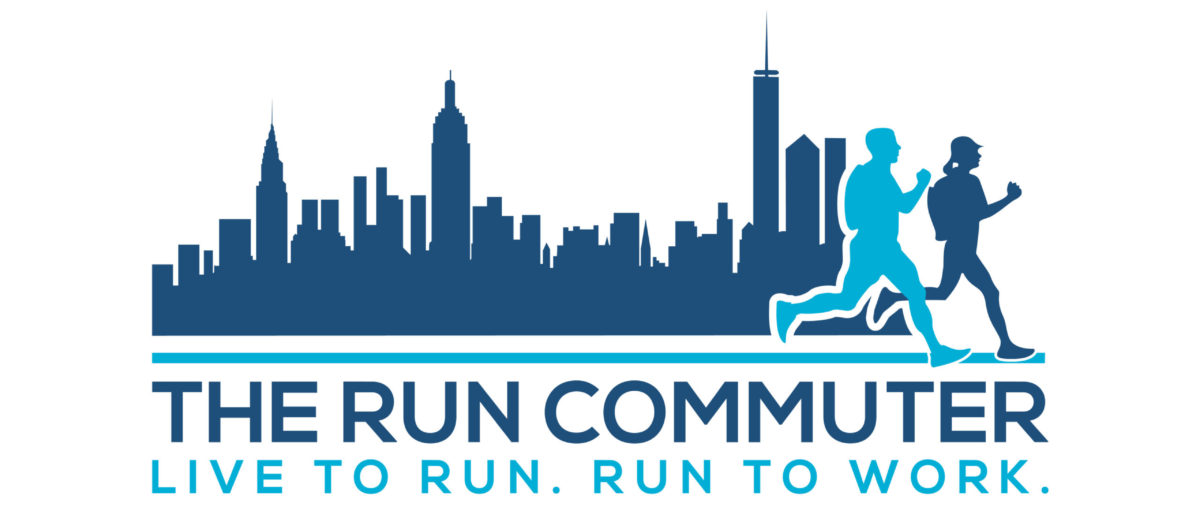
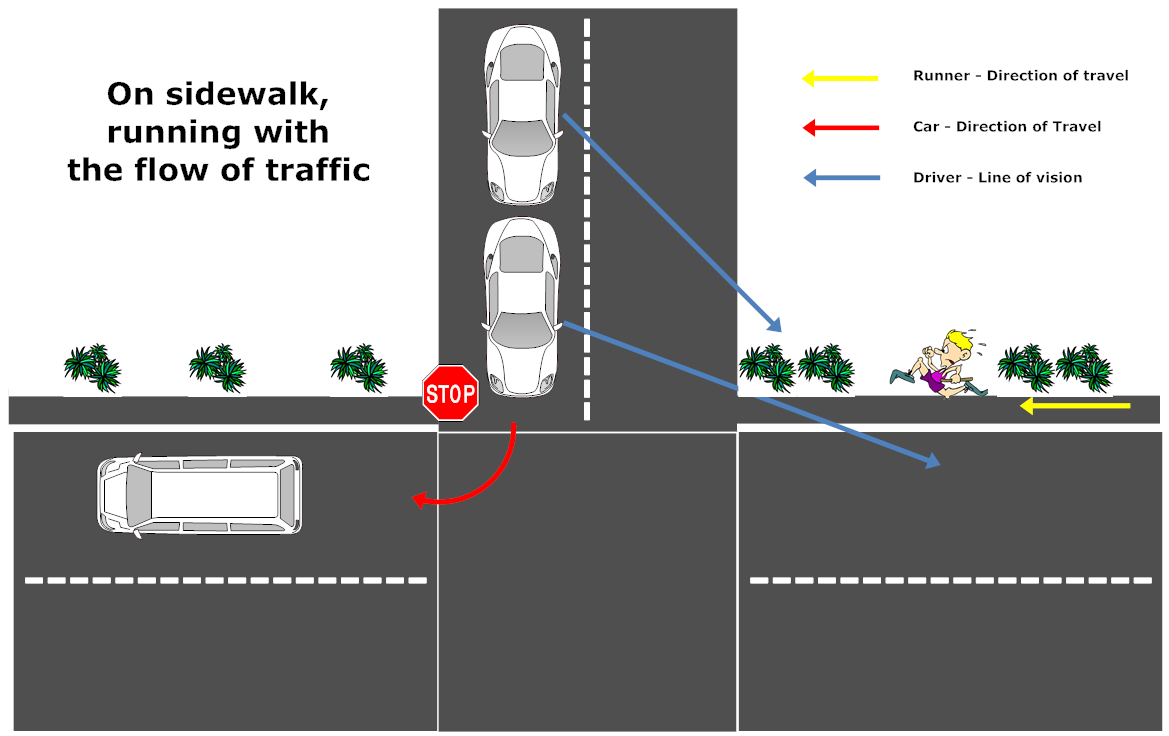
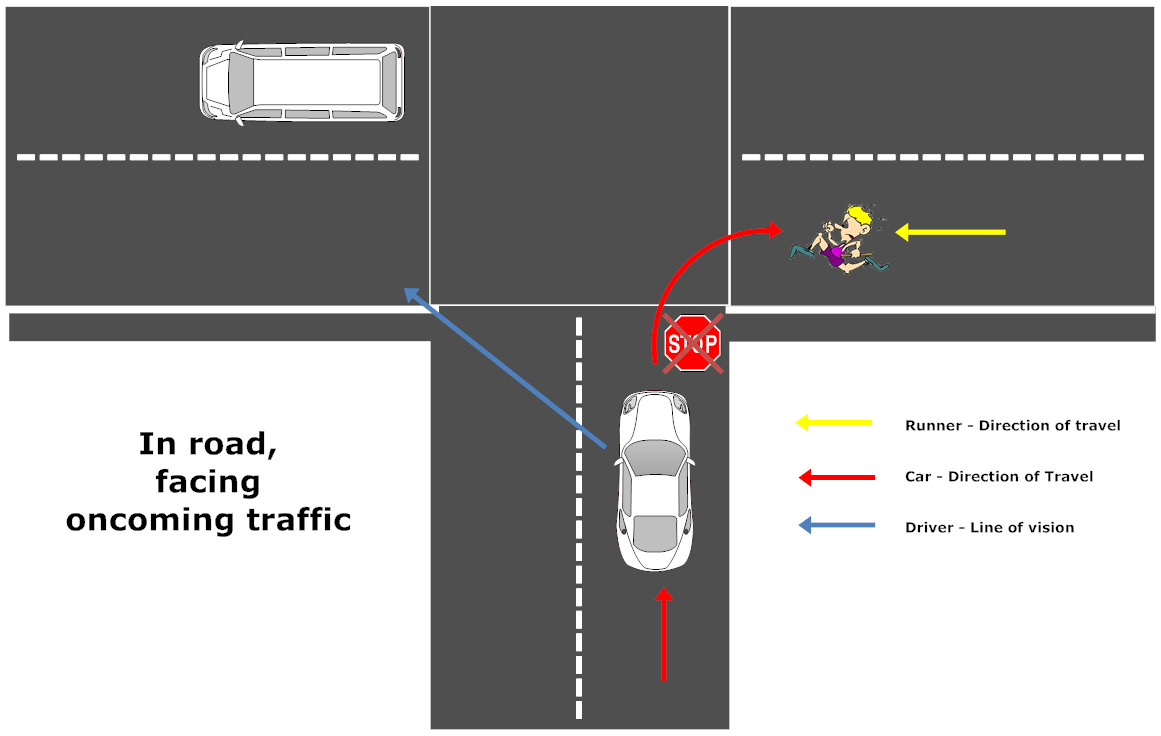
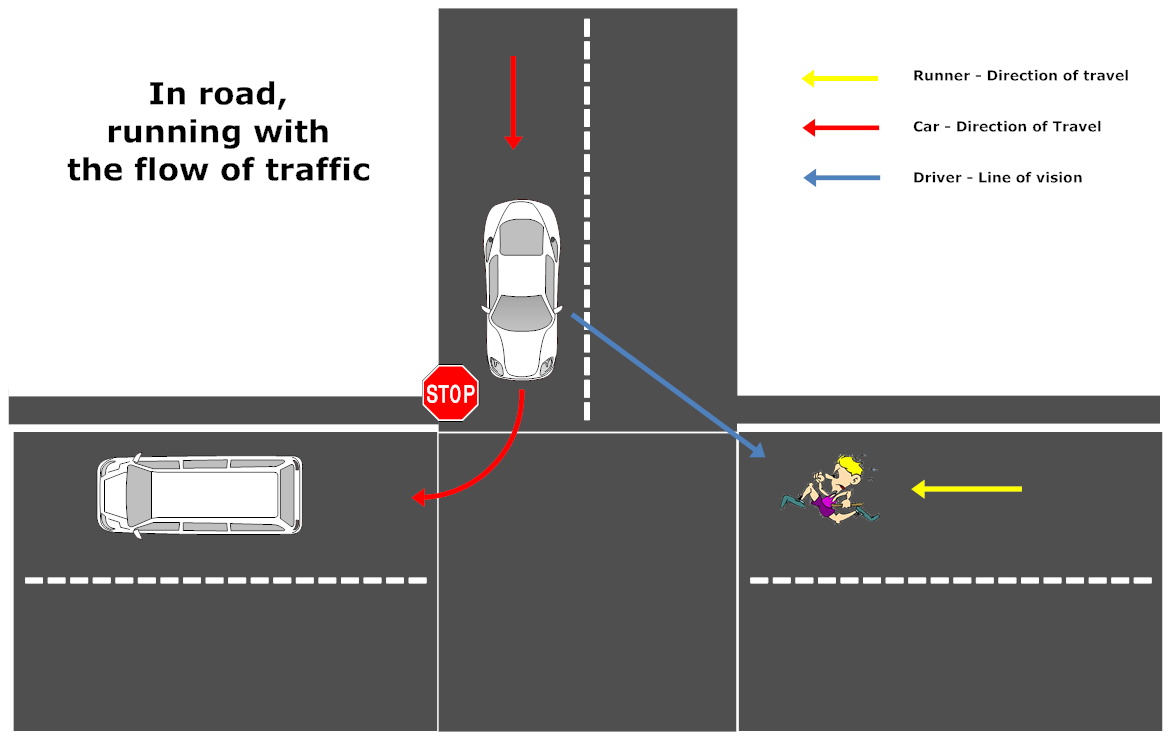
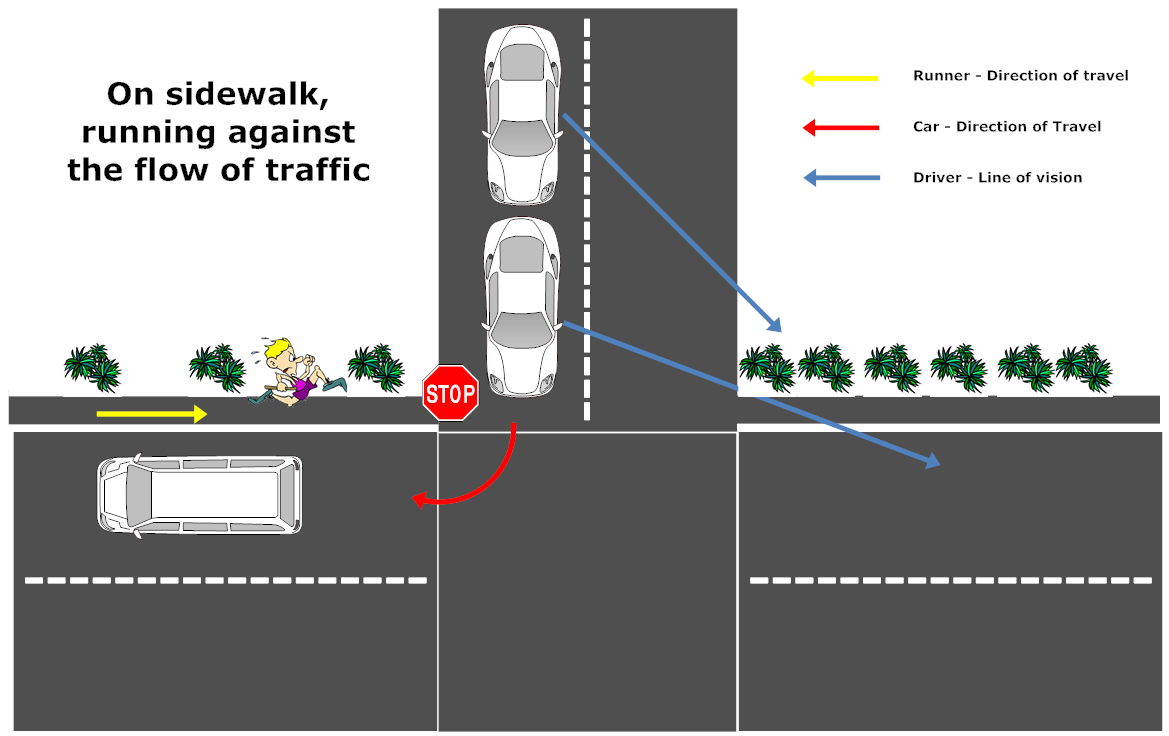
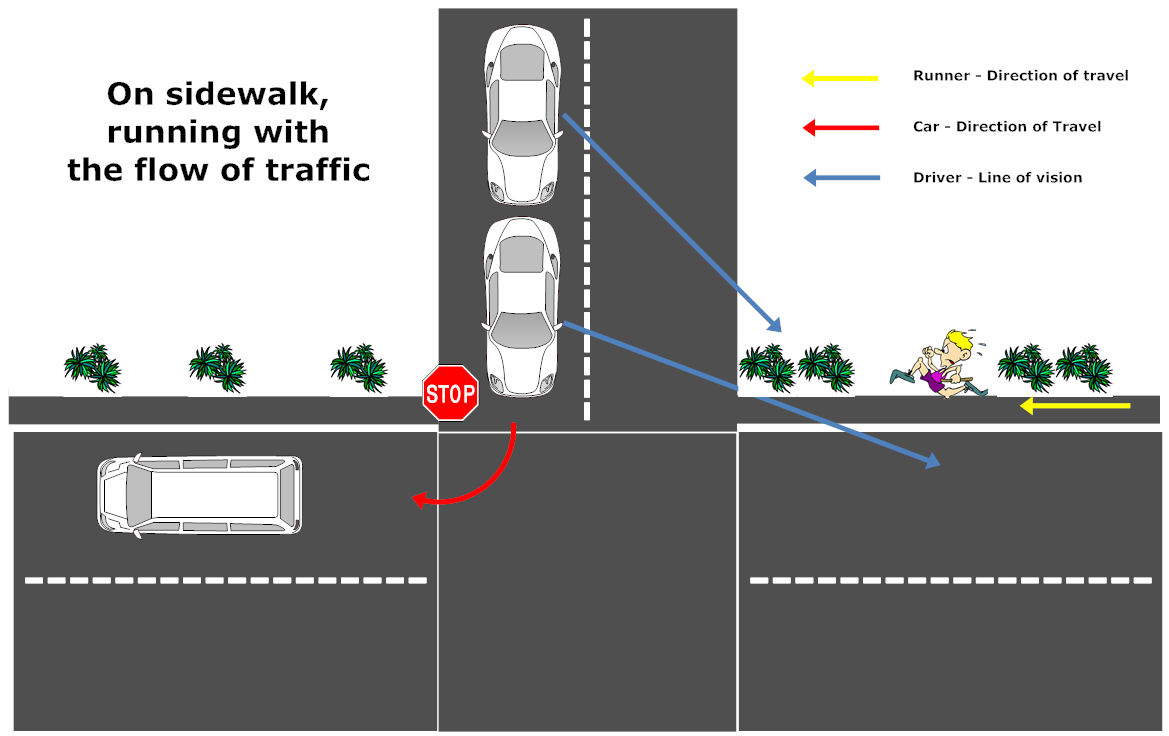
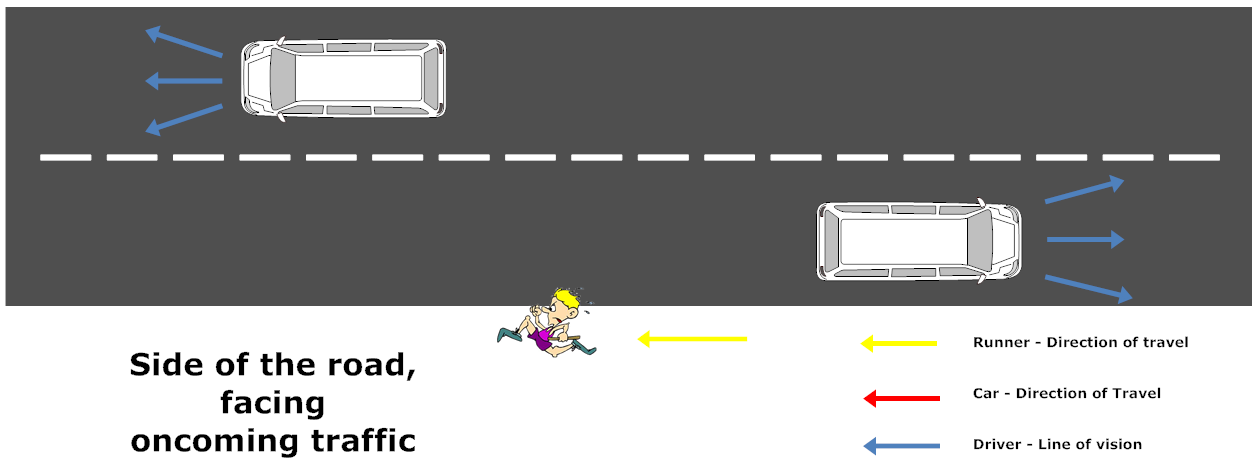
Denver runner here – I just moved from running in the mountains in a more rural environment to running in the city. I can say you hit a bunch of great points here, but I’ll say I don’t usually follow a hard and fast rule when it comes to where I run. Generally I run for ‘Optimal Visibility’ — where I can see potentially hazardous traffic easily, and where they can see me. Running in the mountains, my route had a few blind curves where I needed to switch sides of the road so that traffic could slow to avoid me as well as any oncoming cars from the other direction, sometimes this meant running on the road with the flow of traffic, not usually my favorite place to be, but necessary. Running in the city, I have more ‘grid’ issues and right-turning cars to avoid, but I also have the benefit of sidewalks. I think you should run like you should drive: defensively. Assume that every car will accidentally run you over, and do your best to make sure they don’t.
That’s great advice for runners, walkers and cyclists alike!
I understand that every runner is the fasted in the world, but please please stay out of the bike and cycle track lines. Cyclist already have enough to be concerned with. Plus, “Share the Road” does not apply to pedestrians (and that includes runners – fast pedestrians). If there is a sidewalk, please use it. If it’s too crowded – find a side street route. Also, wearing a blinkie red light can also be useful especially at crosswalks.
Agreed! Kyle brought this up early last summer in When Cross-Type Commutes Cross Paths.
Bicycle Bug, I agree with you wholeheartedly, as Josh pointed out. When riding, I have played chicken with runners (and won); when running, I have chided them for occupying the bike lane. Then sped off into the distance: shame delivered, retaliation prevented!
But your argument makes the case for Share the Road’s application to pedestrians. Share the Road entitles neither drivers nor bikers to a free-wheeling grab-all, but reminds them to proceed by the rules that govern them, and to be courteous when in conflict. Sure, runners/walkers should keep out of bike lanes, but vehicles must yield when they cross a road (not barrel down it). As you have no doubt noticed at pretty much any cross walk, pedestrians receive the least consideration.
I run in Vancouver, Canada and I always stay on the sidewalk – not because I want to but because I find it hard enough to avoid the drivers who run stop signs and red lights and on and on – every run daylight or dusk I find myself narrowly missing serious injury – it is one of the reasons I almost entirely stick to trails now. I’ve had too many close calls – I completely agree with the statement above about assuming you will get hit.
And just in case you’re curious as to my safety I wear bright colors, a reflective vest in addition to reflective clothing and a head lamp for when I’m not on a lit sidewalk – still is a hazard around these parts.